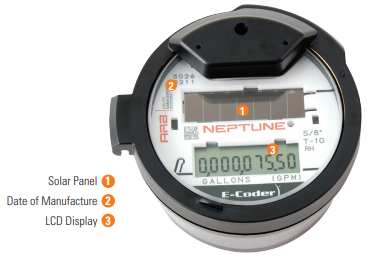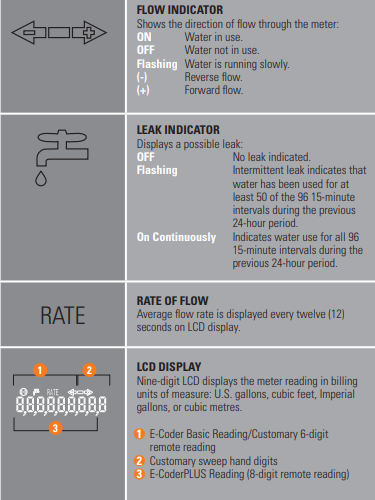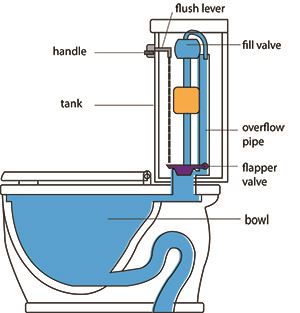How do I check for leaks in my home?
Your Water Meter

The water meter in your home or business will look similar to the meter on the left. The meter has a digital readout like a car odometer that records the number of gallons that have passed through the meter since it was installed. To activate the screen you will need to use a flashlight to charge the solar panel. Hold the light above the panel for 5-10 seconds and it will activate the screen. Once the screen is active it will go through a startup then display the usage through the meter. If you wait another 5- 10 seconds it will display the usage of the meter at that time in Gallons per hour (GPH). If water is being used it will display here for you to see.
Here is a list of all the displays ther water meter has on it.


Checking for leaks
The most common source of high water bills due to leakage in homes is the result of leaks on toilets. If the display says water is being used when no water running in the house, there are two checks that should be made on each toilet in the house. First, lift the cover off the tank on the back of the toilet. There is an overflow pipe to prevent the tank from overflowing onto the floor in the event the toilet fill does not shut off. The water level in the tank should be approximately three-quarters of an inch (0.75 inch) below the top of the overflow pipe. The float that is used to shut off the fill to the toilet can walk out of adjustment over time, causing the water level in the tank to rise to the point where water begins to flow into the overflow pipe.This is a very silent and almost undetectable leak, but this is the single most common leak the Water Department finds when investigating high water bills. If you find this problem, the float on the toilet needs to be adjusted to lower the water level, based on the manufacturer’s recommendations. The second type of toilets leak allows water to leak from the tank into the bowl due to the flapper valve or flush valve not seating properly. To check for this type of leak, add a few drops of food color to the tank. If the color shows up in the bowl (without flushing the toilet), you have a leaking flapper valve. Leaks on underground piping – such as lawn irrigation systems – can also go unnoticed, and can waste a huge amount of water.
Other leaks, such as leaks on sinks or showers or even hoses, are more evident in that you can see or hear water dripping. Be aware that leaks – even very slow leaks – because they are running 24 hours a day, 7 days a week, can waste a large amount of water and increase your water bill significantly.










